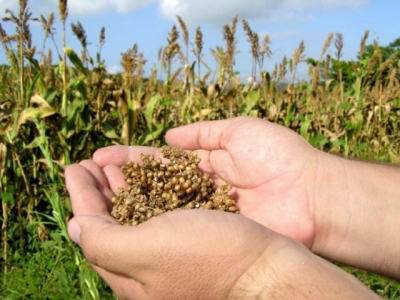High-density feed crop planting could reduce weeds, herbicide use

Planting some feed crops in a grid pattern may limit the need for herbicide use or mechanical weed control.
The high-density system was devised after years studying competition among plants, said Jacob Weiner, professor in the Department of Plants and Environmental Sciences at the University of Copenhagen.
“We have learned a lot about the mechanisms though which plants compete,” he told FeedNavigator. “I believe we can use this knowledge to reduce weed problems in agriculture.”
The process has generated interest because it would allow for a reduction or elimination of herbicide use, he said. There has been concern about the continued effectiveness of such products and the environmental influence from their use.
“If we can develop this approach to the point that farmers can avoid herbicides completely (so they do not have to buy the spraying equipment or the chemicals), then this approach would be [economically] competitive,” he said.
Results
Recent experiments in Columbia tested the grid model, or high-density planting system, in maize, said the researchers. Weeds remain one of the primary causes of feed crop yield loss.
The group had test plots at three different densities, 5, 7 and 10.5 seeds m-2 and compared plant growth in both rows and grids. The crops were grown with a weed challenge from brachiaria brizantha.
“On average, weed biomass was reduced (by 72% in the first year and 58% in the second year), and grain yield was increased (by 48% and 44%) at the highest density in the grid pattern compared with standard sowing practices (medium density, row pattern),” they said.
System details
The planting system works by altering the way in which crops are spaced in the field, said Weiner. Some crops are able to suppress weeds if they are planted tightly together rather than in a row pattern.
“Suppression of weeds by the crop should increase with crop density and crop spatial uniformity,” he said. “By increasing the crop density, we increase the proportion of plants in the field that are crop plants.”
The alternative planting system works because field crops have initial advantages against weeds, he said.
“The crop has a size advantage – it is larger than the weeds at the beginning, because weeds have very small seeds compared to the crop,” said Weiner. “By increasing the crop density and uniformity, we make much better use of this ‘initial size advantage,’ and by increasing the density and uniformity, the crop's canopy of leaves will cover the weeds and shade them before the weeds are large enough to do anything about it.”
The system could allow for either a reduction or elimination of herbicide use to control weeds in a field, he said.
Not all crops have the ability to suppress weeds, he said. Some, like onions, evolved to combat other production challenges.
“But most major crops, especially cereals and maize, do have the ability,” he said. “If competition between crops and weed is intense (high density) and if the crop is spread out in 2 dimensions (spatial uniformity).”
Remaining challenges
However, the process does have a few challenges that still need to be addressed, said Weiner.
“Before this idea can be widely applied, a seeding machine that can sow at high density in a uniform pattern needs to be developed,” he said. “While this is eminently doable, agricultural machinery companies have to believe there is a market.”
Currently, there are some companies working on prevision seeders for other types of crops that might be able to be repurposed, he said. “And even this is not a problem for larger crop plants, e.g. maize, where the current technology is already sufficient,” he added.
Weiner’s research team in Denmark used a rebuilt precision seeder to plant its high-density wheat plots, he said.
However, there is no problem in harvesting a crop planted this way, he said.
What’s next?
The group is currently looking to expand its work with a study of plants, said Weiner.
“To take these ideas further and eliminate herbicides, we have tdwould be advantageous for the crop i-density, high-uniformity enviroment,” he said. “We are now applying evolutionary theory to plant breeding in this context.”
Related news
 Southern Winter-Spring rice crop area down due to floods
Southern Winter-Spring rice crop area down due to floods Southern localities have planted about 764,500 hectares of the Winter-Spring rice crops so far this year, down 14.4% from the same period last year as flood
 Fruit, veggie exports set record of US$3.45 billion
Fruit, veggie exports set record of US$3.45 billion Vietnam earned a record of some US$3.45 billion from fruit and vegetable exports in 2017, rising by 40.5 percent from last year, according to the Ministry
 Fruits of labor
Fruits of labor The bar is high, but fruit and vegetable exports are an area of particular potential for Vietnam.